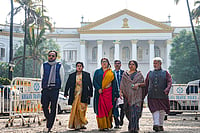The electric vehicle (EV) market is rapidly transforming, driven by advancements in battery technology, charging infrastructure, and a global shift towards sustainable energy solutions. As EV adoption accelerates, these developments are set to redefine the future of transportation, offering longer driving ranges, faster charging times, and a more integrated energy landscape.
At the forefront of this transformation is Parth Chandak, a professional whose work bridges the gap between mechanical engineering, computer science, and data-driven sustainability. With a deep experience in mechanical engineering, Parth has applied his diverse skills to address some major challenges in EV infrastructure—particularly those related to smart data collection and route optimization.
Currently leading data innovation initiatives for urban mobility and clean energy solutions, Parth is a thought leader in EV logistics systems and real-time infrastructure analytics. His projects span both public and private sectors, including collaborations with municipalities, automotive startups, and academic research labs.
“What inspired your interest in electric vehicle infrastructure?”
Having earned a degree in mechanical engineering, Parth Chandak initially ventured into the broader transportation sector. But it wasn’t until he began examining the data challenges behind electric vehicle (EV) adoption that he found his true passion.
“I’ve always been fascinated by how data can unlock real-world solutions,” says Parth. “EV infrastructure is like a puzzle where engineering meets intelligent systems—that’s where I thrive.”
According to him, the charging ecosystem offered a rare opportunity to combine technical expertise with tangible environmental impact—a rewarding convergence of sustainability, engineering, and innovation.
“What are some key challenges in optimizing electric vehicle charging networks?”
“The road to predicting charging demand excellence is certainly not without hurdles.”
Parth identifies a major obstacle in predicting charging demand across regions with varying climates, geography, and driver behaviors.
“You can’t rely on one-size-fits-all models,” he notes. “EVs behave differently on a snowy hill in Colorado than on a highway in Arizona.”
He emphasizes the importance of real-time information—location, availability, and wait times—especially for long-distance EV travel.
“Without good tools, planning becomes a stressful, manual process. That’s where technology can really shine.”
Another critical hurdle is ensuring high-quality, consistent data.
“Getting clean, reliable data is harder than it sounds,” Parth shares. “You need a system that captures everything from temperature and elevation to traffic congestion and battery degradation.”
What types of tools have you developed to address these challenges?
Parth has developed a suite of logistics and planning tools using VBA, PowerQuery, and advanced data visualization frameworks. These tools help EV operators and planners make smarter, faster decisions.
“We didn’t just want better maps—we wanted smarter maps that think like EV drivers,” he explains.
He created interactive dashboards and AI-powered visualization platforms to detect charging behavior trends and infrastructure gaps. These tools are now being used by regional planning authorities and private charging networks alike.
Another key innovation has been automation. By eliminating hours of manual data collection and cleaning, Parth’s tools allow teams to focus more on strategic decisions and less on operational bottlenecks.
How important is real-world testing in developing these systems?
“Nothing replaces real-world experience,” Parth insists.
He’s led and participated in multiple cross-state road trips, collecting data on EV performance in extreme conditions—cold weather, high elevations, and variable terrain.
“You can simulate forever, but you won’t understand EVs until you drive one across three states in a snowstorm.”
These trips helped surface overlooked factors—like how elevation affects range estimates or how wind chill impacts charging speed—and informed the refinement of his tools.
What measurable impacts have you seen from these innovations?
Parth’s automation systems have significantly reduced manual processing times, freeing teams for higher-value work like analytics and planning.
His EV route optimization tools have shortened trip planning times from 30–45 minutes down to just a few, helping drivers reduce “range anxiety” and trust the system.
“We built predictions drivers could trust. Confidence is everything on the open road,” he adds.
He’s also helped energy planners identify optimal charging locations, cutting down on infrastructure costs and improving accessibility for EV users.
What challenges did you face when implementing these solutions?
Parth notes that building a cross-functional team was one of the major, yet beneficial challenges.
“Engineers speak torque, developers speak code, and analysts speak data. Bridging those worlds took work—but it was worth it.”
He also had to deal with inconsistent datasets and the lack of standardized metrics in the early stages of development.
“We had to build trust in the data before we could build trust in the system.”
Additionally, resource constraints often meant prioritizing which data to collect in the field.
“We had to act like data detectives—getting maximum insight with minimum effort.”
How do you see the future of electric vehicle infrastructure evolving?
Parth envisions a seamless, self-learning system where EVs, chargers, and grid infrastructure communicate automatically.
“In the near future, your car will know exactly when and where to charge—before you even ask.”
He believes the integration of AI and real-time feedback will transform EV infrastructure from static hardware into an intelligent ecosystem.
“We’re moving from isolated stations to dynamic networks that adapt to usage patterns, power availability, and environmental conditions.”
Looking ahead, Parth aims to contribute to the development of smart cities by designing urban data centers that integrate EV systems with broader sustainability goals—like renewable energy grids and green logistics networks.
Ultimately, his goal is simple: “Turn complex data into confident decisions—for planners, engineers, and every driver on the road.”


























